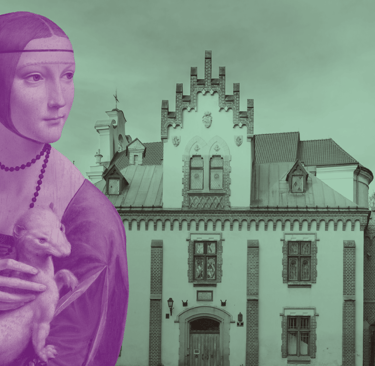Lady with an Ermine by Leonardo da Vinci: A Masterpiece of Mystery and Innovation
Discover the secrets of Lady with an Ermine by Leonardo da Vinci—an iconic Renaissance portrait rich in symbolism, psychology, and technical innovation.
Karolina K.
6/3/20253 min read


Leonardo da Vinci is celebrated not only for iconic works like the Mona Lisa or The Last Supper, but also for subtler gems that exemplify his mastery in capturing psychological depth and symbolic complexity. One such painting is the enigmatic Lady with an Ermine, currently housed in the Czartoryski Collection at the National Museum in Krakow, Poland. This portrait stands among only three surviving female portraits by Leonardo da Vinci, offering a rare window into his unique artistic vision during his Milanese period.
Who Was the Lady with an Ermine?
The sitter in Lady with an Ermine is widely believed to be Cecilia Gallerani, a young woman of intellect and talent who was a prominent figure at the Milanese court. As the favored companion of Duke Ludovico Sforza, Gallerani was known for her poetry, wit, and patronage of the arts. Although her identity cannot be definitively proven, letters and court records strongly support this association.
Leonardo da Vinci, who arrived in Milan in the early 1480s, was closely connected with the Sforza court and is thought to have painted this portrait around 1490, during the height of his Milanese tenure. This timeframe corresponds with fashion trends in the painting and aligns with Leonardo’s intense period of artistic, anatomical, and scientific exploration.
Symbolism and Composition
One of the most intriguing aspects of this painting is the presence of the ermine, an animal rich in symbolism. Often associated with purity and nobility, the ermine was also a personal emblem of Ludovico Sforza. The creature's poised yet alert posture suggests both elegance and protective tension, reflecting perhaps the nature of Cecilia’s relationship with the Duke.
Leonardo da Vinci’s attention to detail is astonishing. From the intricate folds of Cecilia’s gown—featuring nodi Vinciani (knot motifs that appear in other works like the Codex Atlanticus)—to the luminous texture of her skin, the painting reveals Leonardo’s deep interest in anatomy, light and shadow, and psychological realism.
Scientific Techniques and Artistic Innovation
Leonardo da Vinci employed cutting-edge techniques for his time. Infrared analysis has revealed underdrawings, compositional adjustments, and traces of pouncing—a method for transferring preparatory sketches to the panel. Unlike the typical Italian practice of using a gypsum-glue ground, Leonardo used a thin lead white ground with oil, a testament to his technical experimentation.
The pigments used include ultramarine, vermilion, lead-tin yellow, and iron oxide—elements commonly found in Leonardo’s Milanese palette. Interestingly, fingerprints and palm marks discovered on the painting’s surface confirm the artist’s direct hand in its creation.
Restoration and Preservation
Despite its survival, Lady with an Ermine has undergone significant alterations. The original background was overpainted with an opaque black layer, likely in the 19th century. Restoration efforts have tried to recover the original dark hues—possibly brown, green, or gray-blue. Some fine glazes on Cecilia’s face were removed during past cleanings, but the portrait retains a remarkable degree of Leonardo’s original brushwork.
A later inscription reading “LA BELLE FERONIERE LEONARD DA VINCI” and an “LV” monogram, both added posthumously, have confused its identification in the past, but modern scholarship attributes the work confidently to Leonardo.
A Tumultuous Journey Through History
Lady with an Ermine has lived a storied life. Acquired in Italy by Prince Adam Jerzy Czartoryski around 1800, the painting was transferred to his mother’s collection in Puławy, Poland. It was hidden, moved, looted by Nazis during World War II, and even exhibited in Berlin. After the war, it returned to Poland, passing through multiple hands before becoming a permanent piece of the Princes Czartoryski Foundation.
In the decades following 1991, the painting traveled to prestigious exhibitions across the globe—from the U.S. and U.K. to Japan and Spain. While this increased exposure brought international acclaim, it also raised preservation concerns. A 2011 memorandum eventually emphasized the need for careful, science-informed decisions regarding its travel.
Today, the Lady with an Ermine is on display at the Wawel Royal Castle in Krakow, where it continues to captivate art lovers, scholars, and tourists alike.
Legacy and Impact
Lady with an Ermine encapsulates Leonardo da Vinci’s dual identity as artist and scientist. It’s not just a portrait—it’s a psychological study, a symbolic narrative, and a technical marvel that reflects the Renaissance genius’s insatiable curiosity.
As more advanced tools such as multispectral imaging and X-ray fluorescence spectroscopy are used to study this work, new layers of meaning and method continue to emerge. This masterpiece reinforces Leonardo da Vinci’s place not just in art history, but in the ongoing story of human creativity.
Keywords: Leonardo da Vinci, Lady with an Ermine, Leonardo da Vinci painting, Cecilia Gallerani, Renaissance portrait, Leonardo da Vinci Krakow, Leonardo da Vinci artworks, Lady with an Ermine analysis, Leonardo da Vinci symbolism, Czartoryski Collection, Czartoryski Museum
Contact
Contact us via email:
Subscribe to our newsletter!
office@tellmemoretravel.com
© 2025. All rights reserved.
